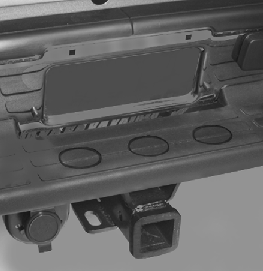Before using a Power Take-Off (PTO), if equipped, refer to the manufacturer's or installer's instructions.
To engage a PTO on a vehicle with a manual transmission do the following:
- Hold the clutch pedal down.
- Set the parking brake.
- Shift the transmission into NEUTRAL.
- Engage the PTO. Refer to the manufacturer's or installer's for instructions on electrically engaged PTOs.
- For mobile operations, shift the transmission into the gear you want, apply the regular brakes and release the parking brake. For stationary operations, leave the parking brake applied.
- Release the clutch and regular brakes as you normally would. When the clutch is released, the PTO will start.
- Turn the PTO rotary switch to ON.
To engage a PTO on a vehicle with an automatic transmission do the following:
- For stationary use shift the transmission into PARK (P).
- Turn the PTO rotary switch ON.
- If the engine speed is below the PTO engage speed limit, the PTO will start. The blinking LED on the PTO control switch indicates PTO engage is requested. When PTO engages the LED will switch from blinking to a steady light.
To use PTO speed control in Preset Mode (Factory Setting) do the following:
- Engage the PTO.
- Select PARK (P) or NEUTRAL (N) range. Apply the parking brake if NEUTRAL (N) is selected. Torque Converter Clutch (TCC) is not available in NEUTRAL (N) and is available only in PARK (P) when engine speed is above 1,100 rpm.
- Make sure your foot is off the brake pedal (and off the clutch on vehicles equipped with a manual transmission).
- Select the desired engine speed for PTO operation. Read the following preset mode information regarding operation.
- PTO Set Speed of 1,250 rpm, or
- PTO Resume Speed of 1,700 rpm.
Please note that the standby speed (800/850 rpm) is not to be used as a PTO control speed. Vehicles not equipped with cruise control will not have the resume speed capability.
To use PTO speed control in variable mode (while mobile) do the following:
- Engage the PTO.
- Vehicle speed must be greater than 5 mph.
- Make sure your foot is off the brake pedal (and off the clutch for vehicles equipped with a manual transmission).
- Select the desired engine speed by using the foot pedal, and select SET on the PTO switch or the cruise control.
To use PTO speed control in variable mode (while stationary) do the following:
- Engage the PTO.
- Vehicle speed must be less than 5 mph.
- Make sure your foot is off the brake pedal (and off the clutch for vehicles equipped with a manual transmission).
- Select the desired engine speed by using the foot pedal, and select SET on the PTO switch or the cruise control.
Vehicles not equipped with cruise control will not have the "tap up" capability.
All engine speed values listed above are factory preset values. With the exception of the TCC lockup speed (1,100 rpm) and the "tap" increment (100 rpm), all of these values are programmable and can be adjusted by your dealer or body upfitter. If the PTO software settings do not match the settings shown here, then they may have already been altered in order to satisfy the requirements of the installed PTO system and body equipment.
When the PTO switch is turned on, the engine is limited to 2,200 rpms. If there are no accessories installed on the vehicle, make sure the PTO switch is turned off.
Step-Bumper Pad
Your vehicle has a rear step bumper with a rear step pad at the center of the bumper.

If you will be using the bumper to tow a trailer, and your step-bumper has three cutout circles, you must push out the center cutout circle to install the trailer ball.
If your step-bumper has only one cutout circle, you will have to cut out the circle, then remove it to install the trailer ball.
